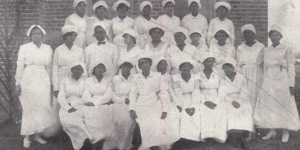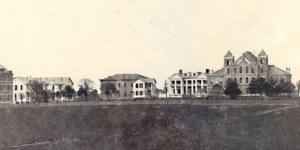Excerpts taken from: “Prairie View, A Study In Public Conscience” by Dr. George Ruble Woolfolk – “A Centennial History of Texas A&M University, 1876-1976 Vol. II” by Henry C. Dethloff Edited by Frank D. Jackson
Establishment – 1876
Prairie View A&M University, the first state supported College in Texas for African Americans, was established during the Reconstruction Period after the Civil War. This was an historical period in which political and economic special interest groups were able to aggressively use the Federal Government to establish public policy, in an attempt to “alter or reshape the cultural milieu of the vanquished southern states”. The University had its beginnings in the Texas Constitution of 1876, which, in separate articles, established an “Agricultural and Mechanical College” and pledged that “Separate schools shall be provided for the white and colored children, and impartial provisions shall be made for both.” As a consequence of these constitutional provisions, the Fifteenth Legislature established “Alta Vista Agricultural and Mechanical College of Texas for Colored Youth” on August 14,1876.
Enrollment of the First Students – 1878
The Board of Directors purchased the lands of the Alta Vista Plantation (1388 acres), from Mrs. Helen Marr Kirby, the widow of the late Col. Jared Ellison Kirby, for the establishment of the State Agriculture & Mechanical College of Texas for Colored Youth. The College was named “Alta Vista Agriculture & Mechanical College for Colored Youth”. The A&M Board of Directors was authorized to appoint a President of A&M College and Alta Vista College with an assigned principal station at Alta Vista to administer the college’s day to day affairs. Confederate President Jefferson Davis recommended Mr. Thomas S. Gathright of Mississippi, also from Mississippi and he brought Mr. L.W. Minor, of Mississippi to serve as Principal. Eight young African American men, the first of their race to enroll in a state-supported college in Texas, began their studies on March 11, 1878.
Names Given to the University – 1998
The Fifteenth Legislature August 14, 1876, established “Alta Vista Agriculture & Mechanical College of Texas for Colored Youth”; The Sixteenth Legislature April 19, 1879, established “Prairie View State Normal School” in Waller County for the Training of Colored Teachers; The Twentieth Legislature in 1887 attached the Agriculture & Mechanical Department to Prairie View Normal School; The Twenty-sixth Legislature in 1899 changed the name to “Prairie View State Normal & Industrial College”; The Forty-ninth Legislature June 1, 1945, changed the name to “Prairie View University”; The Fiftieth Legislature March 3, 1947, established “The Texas State University for Negroes (Texas Southern University) and changed the name of Prairie View University to “Prairie View Agricultural & Mechanical College of Texas”; The Sixty-third Legislature in 1973 changed the name to “Prairie View A&M University”.
The PVAMU Story
Prairie View A&M University, the second oldest public institution of higher education in Texas, originated in the Texas Constitution of 1876. On August 14, 1876, the Texas Legislature established the “Agricultural and Mechanical College of Texas for Colored Youths” and placed responsibility for its management with the Board of Directors of the Agricultural and Mechanical College at Bryan. The A&M College of Texas for Colored Youths opened at Prairie View, Texas on March 11, 1878.
The University’s original curriculum was designated by the Texas Legislature in 1879 to be that of a “Normal School” for the preparation and training of teachers. This curriculum was expanded to include the arts and sciences, home economics, agriculture, mechanical arts and nursing after the University was established as a branch of the Agricultural Experiment Station (Hatch Act, 1887) and as a Land Grant College (Morrill Act, 1890). Thus began the tradition of agricultural research and community service, which continues today.
The four-year senior college program began in 1919 and in 1937, a division of graduate studies was added, offering master’s degrees in agricultural economics, rural education, agricultural education, school administration and supervision, and rural sociology.
In 1945, the name of the institution was changed from Prairie View Normal and Industrial College to Prairie View University, and the school was authorized to offer, “as need arises,” all courses offered at the University of Texas. In 1947, the Texas Legislature changed the name to Prairie View A&M College of Texas and provided that “courses be offered in agriculture, the mechanics arts, engineering, and the natural sciences connected therewith, together with any other courses authorized at Prairie View at the time of passage of this act, all of which shall be equivalent to those offered at the Agricultural and Mechanical College of Texas at Bryan.” On August 27, 1973, the name of the institution was changed to Prairie View A&M University, and its status as an independent unit of the Texas A&M University System was confirmed.
In 1981, the Texas Legislature acknowledged the University’s rich tradition of service and identified various statewide needs which the University should address including the assistance of students of diverse ethnic and socioeconomic backgrounds to realize their full potential, and assistance of small and medium-sized communities and businesses in their growth and development.
In 1983, the Texas Legislature proposed a constitutional amendment to restructure the Permanent University Fund to include Prairie View A&M University as a beneficiary of its proceeds. The Permanent University Fund is a perpetual endowment fund originally established in the Constitution of 1876 for the sole benefit of Texas A&M University and the University of Texas. The 1983 amendment also dedicated the University to enhancement as an “institution of the first class” under the governing board of the Texas A&M University System. The constitutional amendment was approved by the voters on November 6, 1984.
In January 1985, the Board of Regents of the Texas A&M University System responded to the 1984 Constitutional Amendment by stating its intention that Prairie View A&M University become “an institution nationally recognized in its areas of education and research.” The Board also resolved that the University receive its share of the Available University Fund, as previously agreed to by Texas A&M University and the University of Texas.
In October 2000, the Governor of Texas signed the Priority Plan, an agreement with the U.S. Department of Education Office of Civil Rights to make Prairie View A&M University an educational asset accessible by all Texans. The Priority Plan mandates creation of many new educational programs and facilities. It also requires removing language from the Institutional Mission Statement which might give the impression of excluding any Texan from attending Prairie View A&M University.
The University’s enrollment now exceeds 8,000 including more than 2,000 graduate students. Students come from throughout the United States as well as many foreign countries. In the last five years, 5,970 degrees were awarded, including more than 2,400 graduate degrees. During the University’s 130-year history, some 46,000 academic degrees have been awarded
Our Mission
Prairie View A&M University is a state-assisted, public, comprehensive land grant institution of higher education. The university was designated in a 1984 amendment to the Texas Constitution as an “institution of the first class.” It is dedicated to achieving excellence and relevance in teaching, research, and service. It seeks to invest in programs and services that address issues and challenges affecting the diverse ethnic and socioeconomic population of Texas and the larger society including the global arena. The university seeks to provide a high quality educational experience for students who, upon completion of bachelors, masters, or doctorate degrees, possess self-sufficiency and professional competence. The experience is imbued by the institution’s values including, but not limited to, access and quality, accountability, diversity, leadership, relevance, and social responsibility.




